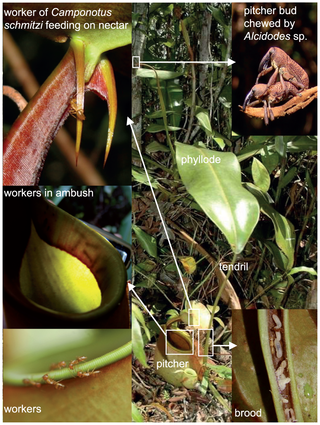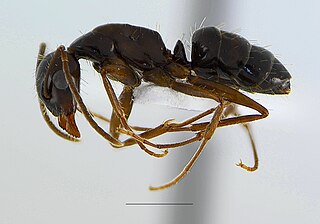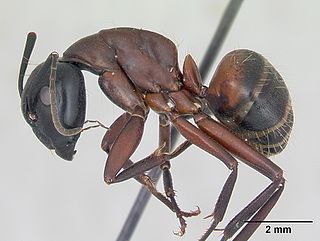
Honeypot ants, also called honey ants, are ants which have specialized workers that consume large amounts of food to the point that their abdomens swell enormously. Other ants then extract nourishment from them, through the process of trophallaxis. They function as living larders. Honeypot ants belong to any of several genera, including Myrmecocystus and Camponotus. They were first documented in 1881 by Henry C. McCook, and described further in 1908 by William Morton Wheeler.

Carpenter ants are large ants indigenous to many forested parts of the world.

The banded sugar ant, also known as the sugar ant, is a species of ant native to Australia. A member of the genus Camponotus in the subfamily Formicinae, it was described by German entomologist Wilhelm Ferdinand Erichson in 1842. Its common name refers to the ant's liking for sugar and sweet food, as well as the distinctive orange-brown band that wraps around its gaster.

The black carpenter ant is one of the largest and most common species of carpenter ant native to the central and eastern United States as well as eastern Canada.

Colobopsis schmitzi, synonym Camponotus schmitzi, is a species of ant native to Borneo, which is commonly known as the diving ant, swimming ant or pitcher-plant ant, due to their habit of diving into the digestive fluids of their plant host Nepenthes bicalcarata. They are endemic to the island of Borneo.

Camponotus universitatis is a species of ant in the genus Camponotus, the carpenter ants. It is native to Eurasia, where it has been recorded in Spain, France, Italy, Switzerland, Albania, Bulgaria, and Turkey.

Joseph Charles Bequaert was an American naturalist of Belgian origin, born 24 May 1886 in Torhout (Belgium) and died on 12 January 1982 in Amherst, Massachusetts.

Camponotus nearcticus, commonly named smaller carpenter ant, is a relatively small carpenter ant. Its appearance is similar to Lasius niger, commonly named the black garden ant. The ant is a household pest.

Camponotus atriceps, previously referred as C. abdominalis, is a species of carpenter ant, endemic to the Americas.

Camponotus japonicus, commonly known as the Japanese carpenter ant, is a species of ant native to eastern Asia. It is black, and one of the largest ants. A nest has about ten to thousands of individuals, and it can be a pest when it enters households or protects aphids. There are several subspecies of this ant in different areas of Asia, with the largest of the species being located in northern China.

Camponotus laevissimus, the giant carpenter ant, is a species of carpenter ant native to western Canada, the United States, and Mexico. Workers measure between 7 and 13 millimetres in length. It is generally shiny black with a blue tint, and the body is covered in short white hairs. The species, which is primarily diurnal, tends to make its nests by hollowing out redwoods. It feeds on the pupae of the western spruce budworm.

Camponotus hyatti is a species of carpenter ant. The species is native to the northern Pacific coast, from Oregon to the Baja California Peninsula. The species is characterized by its five-toothed mandibles and the smooth, shiny appearance of its clypeus, as well as a pronounced metanotal groove, lending the basal surface of the propodeum a distinct convex appearance. It commonly nests in sagebrush, Yucca, manzanita, and oak.

Camponotus herculeanus is a species of ant in the genus Camponotus, the carpenter ants, occurring in Northern Eurasia, from Norway to Eastern Siberia, and North America. First described as Formica herculeana by Linnaeus in 1758, the species was moved to Camponotus by Mayr in 1861.

Camponotus floridanus, or Florida carpenter ant, is a species of ant in the genus Camponotus. First described as Formica floridana by Buckley in 1866, the species was moved to Camponotus by Mayr in 1886. The ant is widespread in Florida and occurs as far north as North Carolina and as far west as Mississippi.

Camponotus socius, the sandhill carpenter ant, is a large species of ant in the genus Camponotus. It was first described by Julius Roger (1863), based on specimens from Brazil - however these can be considered highly dubious as the location where the type specimens were collected (Amazonas) does not fit the known ecology of the species within North America, where it exhibits traits typical of a native species. It is well adapted to the sandy soils of xeric woodlands found within the coastal plains of the southeastern United States. Its range includes the US states of Georgia, Alabama, Florida, North and South Carolina and Mississippi.

The black-headed sugar ant, also known as the brown sugar ant, is a species of Formicinae ant endemic to Australia. Found throughout most states, the species is a member of the genus Camponotus, a cosmopolitan genus of ants commonly known as carpenter ants. It was formally described and named by British entomologist Frederick Smith in 1858. These ants are characterised by their black head, reddish-brown mesosoma and black gaster, which can change in colour.

Camponotus dumetorum is a species of carpenter ant native to North America. They are related to other species from the subgenus Tanaemyrmex in western North America such as C. semitestaceus and C. vicinus. C. dumetorum are primarily nocturnal and form nests underground. Like other select ant species native to California, their populations have been displaced with the introduction of Argentine ants.

An ant garden is a mutualistic interaction between certain species of arboreal ants and various epiphytic plants. It is a structure made in the tree canopy by the ants that is filled with debris and other organic matter in which epiphytes grow. The ants benefit from this arrangement by having a stable framework on which to build their nest while the plants benefit by obtaining nutrients from the soil and from the moisture retained there.

Camponotus ligniperda, the brown-black carpenter ant, is a common species of carpenter ant distributed widely throughout Europe. Found in a variety of woodland habitats, they commonly nest on the ground in dry tree stumps, dead fallen trees, or beneath stones and wooden logs that are partially buried. C. ligniperda is an ecologically dominant species wherever it is found due to both its large size and particularly aggressive nature.



















